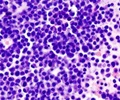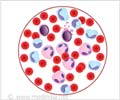Researchers at Ohio State University have discovered that two microRNA (miRNA) molecules help control the oncogene
Researchers at Ohio State University have discovered that two microRNA (miRNA) molecules help control the oncogene responsible for a dangerous form of B-cell chronic lymphocytic leukemia (B-CLL), the most common human leukemia in the world.
Their findings, published in the December 15 issue of Cancer Research, demonstrate that miRNAs are emerging as powerful regulators of gene expression in cancer development, and could offer new targets for drug treatment, the investigators say.In this case, high levels of two miRNAs known as miR-29 and miR-181 seem to suppress expression of the TCL1 oncogene that drives the most aggressive forms of the leukemia, said the study’s lead author, Yuri Pekarsky, Ph.D., assistant professor in the Department of Molecular Virology, Immunology and Medical Genetics at Ohio State University’s Comprehensive Cancer Center.
“We have found a direct inverse association between expression of miR-29 and miR-181 and that of the TCL1 oncogene,” he said. “It works in both directions. High expression of these miRNAs correlates with low expression of TCL1, in the indolent form of cancer that is less likely to progress. A low level of miR-29 and miR-181 is associated with a much more aggressive cancer.”
Drugs that boost production of these two natural TCL1 inhibitors might work as a future treatment for B-cell chronic lymphocytic leukemia, he said. These molecules could also be combined with 12 other miRNAs known to be associated with B-CLL to provide a test that may help determine prognosis and treatment, he said.
Researchers at Ohio State have been leaders in characterizing the role of miRNAs in cancer development. These small molecules are single-stranded RNA molecules that can act either as tumor suppressors or oncogenes. They can block transcription of genes by stopping them from producing messenger RNA or can inhibit translation of the genes by blocking production of proteins from messenger RNA, according to Pekarsky. Earlier this year the investigators provided the first direct evidence that over-expression of an miRNA molecule could result in development of cancer have since identified a number of miRNAs associated with B-cell chronic lymphocytic leukemia that appear to promote tumor development. But the protective miR-29 and miR-181 molecules are emerging as the most important miRNAs discovered to date, Pekarsky said. “MicroRNAs such as these could prove to be as powerful as the protein transcription factors that we know can turn genes on and off,” he said.
The researchers studied TCL1 expression and miRNA expression in 23 samples of indolent B-CLL, 25 samples of aggressive B-CLL, and 32 samples of B-CLL exhibiting a chromosomal deletion, which makes it the most difficult type to treat. They found that TCL1 over-expression correlated with the two most aggressive forms of the cancer. To determine which miRNAs targeted TCL1, they used microRNA-microchips and elaborate computer programs to identify miR-29 and miR-181.
Advertisement
“We have a lot of work to do to characterize these miRNAs because we don’t even know whether they work on transcriptional or translational level,” he said. “But finding that they control this cancer’s major risk factor is a very helpful advance.”
Advertisement
Source-Newswise
SRM








